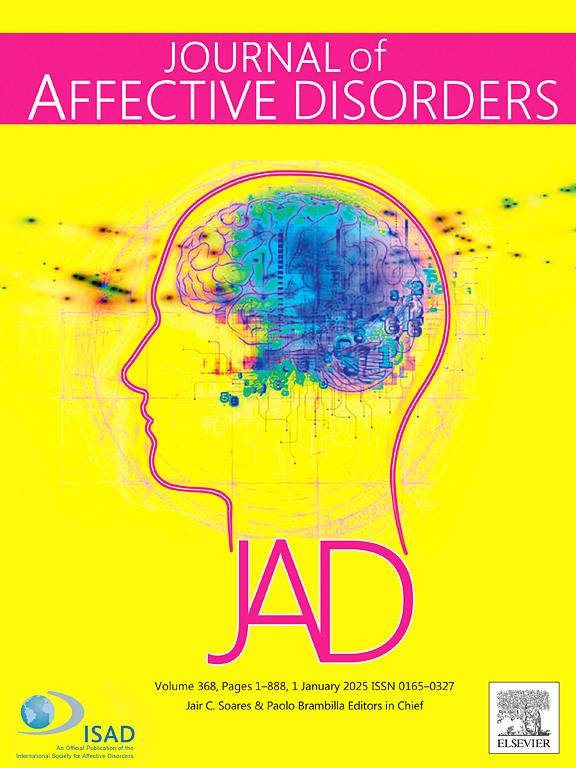消极急迫性与持续关注的关联:来自晚期积极潜能的证据。
IF 4.9
2区 医学
Q1 CLINICAL NEUROLOGY
引用次数: 0
摘要
紧迫感反映了面对强烈情绪时轻率行事的倾向,并与跨越精神病理学领域的一系列适应不良结果有关,包括物质使用、焦虑相关障碍和自杀风险。尽管这种损伤与紧迫感有关,但试图理解这种认知情感风险因素的神经机制的工作却产生了不一致的结果,这表明需要新的方法来理解为什么有些人在积极和消极情绪的背景下更有可能从事冲动行为。一种可能的机制是对情绪信息的持续注意,这是由事件相关电位(ERP)组成的后期积极电位(LPP)来衡量的,它指示了对动机显著性和情绪刺激的持续注意。本研究旨在阐明情绪意象持续注意与自我报告紧迫性之间的关系。社区成年人(n = 62)被招募,根据他们报告的自杀风险因素升高或没有自杀风险历史/存在(健康控制),并被要求完成一个情绪中断任务,在这个任务中,他们在对屏幕上的形状做出反应的同时,观看分散注意力的、与任务无关的消极的、积极的和中性的图像。结果表明,即使在控制了性、负面影响和情绪调节困难的情况下,更大的负面紧迫性与对威胁刺激的持续关注的增强显著相关。然而,需要更多的研究来重复这一发现,将这项工作扩展到更细致的瞬间负面紧迫性评估,并了解情绪失调等其他结构如何调节负面紧迫性对持续注意力的影响。本文章由计算机程序翻译,如有差异,请以英文原文为准。
The association of negative urgency and sustained attention: Evidence from the late positive potential
Urgency reflects the tendency to act rashly in the face of intense emotion and has been associated with a host of maladaptive outcomes spanning psychopathology domains, including substance use, anxiety-related disorders, and suicide risk. Despite the impairment associated with urgency, work seeking to understand the neural mechanisms of this cognitive-affective risk factor has yielded inconsistent results, suggesting the need for new approaches to understand why some individuals are more likely to engage in impulsive behaviors in the context of positive and negative emotions. One possible mechanism is sustained attention on emotional information, measured by the late positive potential (LPP), an event-related potential (ERP) component that indexes sustained attention toward motivationally significant and emotional stimuli. The present study aimed to elucidate the relations between sustained attention to emotional images and self-reported urgency. Community adults (n = 62) were recruited based on their report of either elevated suicide risk factors or no history/presence of suicide risk (health controls) and asked to complete an emotional interrupt task in which they viewed distracting, task-irrelevant negative, positive, and neutral images while responding to shapes on the screen. Results indicated that greater negative urgency was significantly associated with heightened sustained attention to threatening stimuli even when controlling for sex, negative affect, and difficulties in emotion regulation. However, more research is needed to replicate this finding, extend this work toward more granular assessments of momentary negative urgency, and to understand how other constructs such as emotion dysregulation moderate the effect of negative urgency on sustained attention.
求助全文
通过发布文献求助,成功后即可免费获取论文全文。
去求助
来源期刊

Journal of affective disorders
医学-精神病学
CiteScore
10.90
自引率
6.10%
发文量
1319
审稿时长
9.3 weeks
期刊介绍:
The Journal of Affective Disorders publishes papers concerned with affective disorders in the widest sense: depression, mania, mood spectrum, emotions and personality, anxiety and stress. It is interdisciplinary and aims to bring together different approaches for a diverse readership. Top quality papers will be accepted dealing with any aspect of affective disorders, including neuroimaging, cognitive neurosciences, genetics, molecular biology, experimental and clinical neurosciences, pharmacology, neuroimmunoendocrinology, intervention and treatment trials.
 求助内容:
求助内容: 应助结果提醒方式:
应助结果提醒方式:


